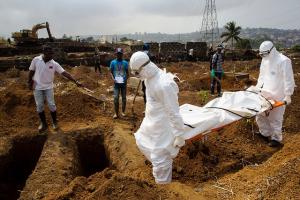An early September assessment of burial practices in some of Sierra Leone’s Ebola hot spots revealed a host of problems that were probably helping fuel ongoing virus transmission in the country, experts from the US Centers for Disease Control and Prevention (CDC) and Sierra Leone’s health ministry reported today.
The team conducted its first assessment in three high-risk areas, focusing on burial practices, cemetery management, and adherence to recommended practices. Then they looked at the issues again the following month on a broader scale ahead of the Sierra Leone government’s national rollout of standard procedures for safe and dignified burials. They published their findings in Morbidity and Mortality Weekly Report (MMWR).
Viral levels are highest in people who are severely ill with Ebola and after people die from their infections, making handling of bodies one of the highest transmission risks.
Traditional funeral practices, such as touching and washing the bodies of loved ones, are among the factors that led to the early spread of the disease in West Africa and is still a concern that responders have addressed with messaging and the development of safe burial options that respect religious and cultural rituals.
Sifting through burial practices
The team conducted its first assessment in September at five sites in three of Sierra Leone’s districts that reported high Ebola activity: Western Urban, Western Rural, and Port Loko. They looked at the practices of burial teams, swab collection teams, and cemetery management teams. Investigators also visited cemeteries designated for Ebola victims.
The group also interviewed families and community members near homes where burial teams were removing bodies in efforts to gauge perceptions about body-handling practices.
Initial assessment found that it could take as long as 1 to 5 days for a burial team to retrieve a body and that there were several problems with coordinating case investigation and swab collection, as burial teams often buried bodies before a swab could be collected or before the case investigation was complete. Burials also often bypassed official reporting protocols, which led to underreporting.
Burial teams collected up to 10 bodies each day, requiring frequent donning and doffing of personal protective equipment (PPE). The workers observed good infection control practices while handling the bodies, but they had limited capacity to decontaminate homes and didn’t remove bedding and other contaminated materials, despite recommendations.
During the cemetery visits, the researchers found that graves were sometimes hand dug and not to the recommended depth, and multiple bodies were often placed in a single grave. Given problems disposing of contaminated PPE, burial teams sometimes buried the materials on top of bodies, nearly filling the graves and posing problems of medical waste not being buried to the appropriate depth.
Families were not often allowed to observe cemetery burials, but some safe community burials were taking place in some areas.
Findings shape country protocols
Sierra Leone health officials used the findings from the assessment to develop standard operating procedures for safe burials, which were unveiled on Oct 1, with a burial command center launched on Oct 19. The country also launched a “Safe Burials Save Lives” campaign to sensitize the population.
Health officials are making more efforts to respect burial customs, such as using shrouds for Muslim families and allowing families to give burial teams special clothing to dress their loved ones in before burial.
The investigators concluded that bodies are now being buried in a safer and more dignified manner in Sierra Leone, but documenting the improvements is needed. They warned that unsafe, secret burials continue to be reported in the country, which spark new outbreaks.
Continued efforts to improve the dignity of the burials, as spelled out in the country’s operating procedures, might increase community acceptance of safe burials and help curb disease transmission, they wrote.
Other developments
- An American health worker potentially exposed to Ebola in Sierra Leone who was evacuated from the outbreak region and admitted to Nebraska Medical Center’s biocontainment unit on Jan 4 remains virus-free, according to a Twitter post yesterday from the facility. The unidentified patient will continue to be monitored for 21 days, it said.
- A call-in center that was part of a 3-day house-to-house search for Ebola patients in Sierra Leone in September received about 1,100 calls per day, with 36% reporting possible infections and 39% reporting deaths, according to a review of the system conducted by experts from the CDC and the country’s health ministry published today in MMWR. Telephone operators were able to notify response teams about the possible illnesses and the deaths. Follow-up analysis found that the calls triggered a same- or next-day response for 81% of reported deaths but only 45% of reported possible cases. The researchers concluded that because isolating and treating sick patients is a key to battling Ebola, the need to scale-up response services is urgent. They also noted that call centers can be useful for providing credible information to the public and are poised to facilitate prompt transfer of patients to Ebola treatment units.
- A high-level delegation of United Nations (UN) officials yesterday met with Guinea’s president, according to a daily update from the UN Mission for Ebola Emergency Response (UNMEER). The visit is part of a series of meetings with the leaders of Guinea, Liberia, and Sierra Leone, in connection with the transition to a new UNMEER leader, Ismail Ould Cheikh Ahmed.
- The World Health Organization (WHO) said today that the number of illnesses reported so far in the three hardest-hit countries is 21,171, with the number of deaths at 8,371, the same numbers reported yesterday. The new totals include data through Jan 10 in Guinea and Sierra Leone and through Jan 7 in Liberia.

